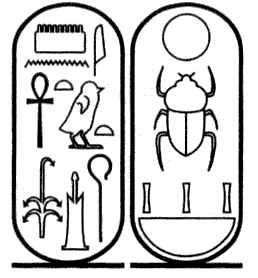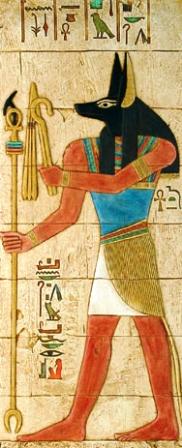
| The Was Sceptre | 
|
|
Ancient Egyptian Gods and Goddesses for kids - Was Sceptre The history of ancient Egypt and the significance of the Was Sceptre |
|
Was Sceptre
Discover the history and beliefs surrounding the 'Was Sceptre' which features in so many images and pictures of ancient Egypt. The 'Was Sceptre', sometimes referred to as the 'Heqa or Heq sceptre' was a symbol of divine power and an emblem of authority. The 'Was Sceptre' was one of the most important Egyptian Symbols and was depicted being held by ancient Egyptians, Pharaohs, images of gods and goddesses and Priests. The Was Sceptres linked the divine power of the Pharaohs with the power of the ancient Egyptian gods and became one of the most famous emblems of Egyptian authority and kingship. The 'was' sceptre was also believed to be another type of magical fetish. |
|
Facts about the Was Sceptre
The Was Sceptre was an important item in the regalia of the most important and influential personages in ancient Egypt. Depictions in art, artefacts, relics and examples of the Was Sceptre can be found in the tombs, temples and manuscripts of the ancient Egyptians. Look at the top of the page, and the other images contained in this, and other articles on ancient Egypt, and you will see many depictions of the Was Sceptre.
Was Sceptre Fact File |
Name: |
The Was Sceptre was also known as the Standing sceptre, Heqa Sceptre and in Egyptian as an 'uas' or 'ouas'
| | Description & Definition: | Description & Definition: The Was Sceptre is described as a long rod or staff. The top of the staff or rod took on an abstract design or shape, believed to represent the head of an animal. The bottom of the staff was bifurcated, meaning that it was divided into two branches or forks
| | Materials: | The materials used to make a Was Sceptre varied but could be constructed from wood, ebony, ivory or precious metals such as gold and occasionally silver
| | Status: | The Was Sceptre was part of the regalia, an indication of status during formal occasions, that was carried by Pharaohs, Priests, Nobles, Officials, Gods and Goddesses
| | Symbol: | The 'was' sceptre symbolized divine power and was an emblem of authority
| | Fetish: | The Was Sceptre was believed to be a fetish, an object that was believed to embody magical powers, used to create a bond between the mortal world and the Underworld |
|
|
The Head of the Was Sceptre
The top or head was often fashioned in the shape to represent the head of an animal. Facts about the Was Sceptre in Egyptian Mythology and History
Discover interesting information and research facts about the Was Sceptre, the iconic Egyptian symbol. The facts about the Was Sceptre provides a list detailing fascinating additional info to increase your knowledge about the Was Sceptre in Egyptian Mythology and history. Facts about the Was Sceptre from Mythology and History |
Fact 1: |
The first representation of a Was Sceptre dates back to the first dynasty
| | Fact 2: | Its origins are believed to relate to the staff called the 'heqa' that was used by Egyptian shepherds to control their animals
| | Fact 3: | The staff stood for 'dominion' and also for 'wellbeing'
| | Fact 4: | The rod was perceived as a magical tool could fight the demons of the Underworld
| | Fact 5: | The staff was often composed of alternating bands of blue and gold
| | Fact 6: | The rod appeared as a decoration on funerary equipment
| | Fact 7: | The length of the staff varied but it originally measured about six and a half feet (two metres) in length
| Facts about the Was Sceptre from Mythology and History |
|
|
Was Sceptre- Interesting research information and Facts about the Egyptian Was Sceptre
- Was Sceptre, the regalia of ancient Egyptians
- History and Egyptian Mythology associated with Was Sceptre
- Facts and information about the gods and deities of of classical Egypt for schools, research and kids
- Pictures, Description and description of the Was Sceptre for kids
|
| | |
|
The Was Sceptre - Symbol of Power & Authority
The Was Sceptre was a symbol of power and authority and formed part of the part of the regalia carried on formal occasions by ancient Egyptian Pharaohs, Priests, Gods and Goddesses. The picture of the left depicts Anubis with various symbols of power and authority including the Was Sceptre. The other symbols that are often depicted in in hieroglyphics featuring Pharaohs Gods and Goddesses are: - The Ankh: The Ankh, also known as key of life, was depicted as a "cross with a handle" that represented eternal life
- The Crook: The crook symbolized the role as the 'shepherd' of the people
- The Flail: The flail symbolized the role as provider of food for the people
- The Djed: The djed was a pillar-like symbol used in in hieroglyphics representing stability
- Crowns and head-dresses were symbols of power and status
- Animal Heads: Gods and goddesses were depicted with the bodies of humans with the heads of animals that instantly conveyed the identity, qualities and attributes of the god
- The Shen: The Shen ring (represented in hieroglyphs as a stylised loop of a rope) formed the encircling elongated ring of the cartouche which enclosed and protected a royal name. The picture of the Shen ring encircles the cartouche of Tutankhamen

| 
|
|
|
|
|